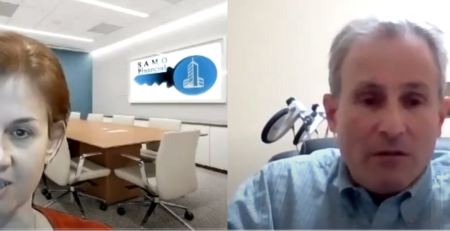What is Passive Real Estate Investing and how do I begin?
What is Passive Real Estate Investing and how do I begin?
Alina Trigub, the founder of SAMO Financial, had the pleasure of speaking with Dr. Allen Lomax of Steedtalker Capital during the 106th episode of Creek Side Chats, a podcast designed for real estate entrepreneurs.
During this episode, Alina shares the courageous and inspiring story that piloted her into a real estate career. She now helps new and experienced investors who want to gain diversification and tax benefits through passive real estate investments.
About the Episode: Building Wealth Through Passive Investing
After immigrating to the United States, Alina became curious about assuring her financial future. Real estate had been in the back of her mind for many years.
Drawing from a background in accounting and project management, she became interested in syndication investing and got involved with real estate meetup groups to learn by immersion in the world of real estate.
Like many of us, Alina at first didn’t feel she had much to contribute. Over time, she overcame her doubts and began to understand the strengths she could offer to other real estate investors.
Leaning on her extensive knowledge of taxes and project delivery, Alina established herself as a strategic entrepreneur.
Positive that she can help people who want to build wealth by passively investing in real estate, Alina has since worked unremittingly to offer her investors participation in over 1200 apartment units, a $10MM storage fund, and a $10MM mobile home fund park, and many other various real estate projects and funds.
To listen to the podcast episode, check it out here.
So exactly what is passive real estate investing, and how can it help you reach your financial goals? We’re going to explore these questions in this article.
What is the Difference Between Active and Passive Investing?
The primary difference between active and passive investing is the volume of ongoing work an individual dedicates to support the investment.
Active real estate investing offers individuals full control over the project and better tax shield opportunities than passive investments. The flip side is that actively managing the operations of your chosen investment strategy requires significant time and energy.
For instance, the labor and the time involved with house-flipping or handling tenants as a landlord is not desirable to everybody.
That’s why passive investing is so appealing to many busy successful business owners and W-2 professionals!
Passive investing doesn’t mean that you don’t do anything in the investment. It means that you don’t have an active role in managing the daily operational duties of the asset or fund you’ve invested in.
Investors must always perform due diligence before making an investment to ensure the financial decisions they are making are sound.
Passive investors grow their wealth through single asset and multi-asset (aka funds) syndications while avoiding the active role of day to day management. This approach usually comes with slightly lower returns than active investment, because you’re essentially paying someone else to undertake the active role.
That said, passive investors still benefit from tax shields, higher return on your time, and diversification to their portfolio. They also don’t need to have any prior experience before they start investing.
Passive Real Estate Investing
Rather than investing in a material asset, indirect passive real estate investors pool capital into a private equity real estate fund or a single asset syndication. These investments allow an investor to receive a passive income in the form of distributions.
This investment niche doesn’t entail any management from the investor, which makes it completely passive.
Other Ways of Passive Real Estate Investing
There are many different approaches to get you into passive real estate investing. Each offers unique benefits to the investor such as tax shields, diversification, and even potentially telling your boss to go pick a bunch of flowers because you’re heading out the door too.
Real Estate Investment Trusts
When corporations, trusts, or associations invest in income-producing real estate, this is called a REIT. They are traded like a stock and have a modest point of entry – sometimes as little as $500 – opening the gateway for low-capital individuals to begin investing.
Crowdfunding
Real Estate crowdfunding involves an audience of investors who contribute their capital together, to fund a real estate deal. This passive real estate investment strategy makes multi-million dollar deals accessible to investors who wouldn’t otherwise have the money to participate because many individuals accord funds to the project.
Single asset investments, which usually come with value-adding strategies, can make investors lucrative returns.
Typically these deals lend to large assets such as an apartment complex that can appreciate over time.
Through online crowdfunding platforms, investors create an account, select their chosen investment, and pool funds with other investors. Then, all they have to do is monitor the performance of their contribution online, as they yield dividends from the rental income of their property.
Partner With an Active Investor
Here’s an easy one: find someone seeking investment capital who is prepared to actively manage the property for you. This method demands greater upfront investment, but rent pays off the mortgage as you gain equity in the property.
Once the rental revenue exceeds expenses, this strategy brings a steady income stream.
If you purchase the property on your own, you can always outsource the operational duties to a third party. Property management firms attract and screen reliable, trustworthy tenants to reside in the rental. They also handle the day-to-day responsibilities.
Another option is syndication, where you partner with a sponsor seeking capital to make a property purchase. If you need help finding syndicators, SEO for passive real estate investors can put your business directly in front of project managers who are actively seeking capital.
How to Start Passive Real Estate Investing
Many entrepreneurs like Alina Trigub switch careers to become full-time real estate investors.
Jumping into this income generator grants you the freedom to allocate your working hours, secure your retirement, or bid you back some precious time.
However, bear in mind that it does take time to build your annual residual income to match what you may be earning from a 9-5 job.
We advise that you make lifestyle adjustments incrementally until you acquire the ongoing residual income to support your goals.
No matter what, always take the time to do your homework thoroughly and deepen your understanding of what you aspire to accomplish during the venture.
These three questions will put you on the right foot to begin.
What is your goal?
Are you interested in creating a new income stream, or do you want to sit back and watch your wealth grow over time?
Set yourself some goals and a budget to help you identify which strategy works best for you. Your goals will guide you through decisions as you continue to learn and when things change.
Your chosen strategy could vary greatly, depending on whether you wish to grow funds for your retirement over the long term or achieve a lifestyle liberated from your 9-5 job.
How passive do you want the investment to be?
Consider the time and energy you’d like to put into your investment project. As you know, the array of passive investment approaches require varying levels of managerial involvement as well as a multitude of rewards to reap.
Is it crucial that you attain 100% passive status, or can you afford to give a bit more time to the operational tasks to gain higher returns and better tax shields?
Weigh up your options before you select your approach.
Consider your end goal when choosing your strategy.
Where else is your money invested?
In real estate investment, don’t put all of your eggs in one basket! Diversification is key.
If you already have a few coins in the stock market, then a low-risk, long-term investment may add substantial value to the diversification of your portfolio. This is because real estate has no correlation to the stock market.
Do you currently own a residential property? Adding new property types and asset classes like commercial real estate may work well for you as they provide an edge to your portfolio’s diversity.
If you’re not sure where to start with your passive investments, don’t worry! Alina offers coaching and education for those new to passive investing, and who want to learn how.
Summary
By passively investing your capital, you can accrue wealth over the long term and avoid having to be a landlord or manage a property. Instead, just sit back and watch your money grow without putting in the hard yards.
Both the strategy and type of passive investment depend on the goals you establish at the beginning of your journey, so it’s important to weigh your options and select something that works for you.
As someone who has made a career from passive real estate investing, Alina Trigub demonstrates how overcoming your doubts can lead to enormous success through the multitude of approaches to passive investing.
If you want to hear more about the episode, you can listen here.
Have you thought about passively building your wealth via real estate investing?
Let’s talk











